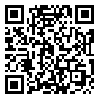Thu, Jun 5, 2025
[Archive]
Volume 11, Issue 42 (Mar 2003)
J Adv Med Biomed Res 2003, 11(42): 9-15 |
Back to browse issues page
Download citation:
BibTeX | RIS | EndNote | Medlars | ProCite | Reference Manager | RefWorks
Send citation to:



BibTeX | RIS | EndNote | Medlars | ProCite | Reference Manager | RefWorks
Send citation to:
Shariati M, Parivar K, Oryan S, Shokravi A, Alizadeh R. The Effect Of A New Phenanthroline Derivative On Serum Testosterone Level And Its Contraceptive Effects On Adult Balb/C Mouse Strain. J Adv Med Biomed Res 2003; 11 (42) :9-15
URL: http://journal.zums.ac.ir/article-1-30-en.html
URL: http://journal.zums.ac.ir/article-1-30-en.html
Abstract: (160040 Views)
Background: Due to the problems arising from the overpopulation, attention has been focused on contraceptives for men. Phenanthrolines are a group of organic compounds with ionophilic characteristics and a wide range of use in biology and chemistry. In this study the effect of 2,6-diaminopyridinum was studied on hypophysis-gonad axis, testicular tissue and sperm production in male Balb/c mice.
Materials and Methods: Fifty adult male Balb/C mice were divided in 5 groups. First group was used as untreated control. Saline was injected to the 2nd group and the remaining 3 groups were received intraperitoneal injection of 15, 20 and 25 mg/kg of 2,6-diaminopyridinum every other day for 20 days. The LD50 was determined to be 35 mg/kg body weight. The serum concentrations of FSH, LH and testosterone were measured and the testicular tissues were studied morphologically.
Results: The data showed that 25 mg/kg diaminopyridinum decreased the serum testosterone level significantly with no changes on FSH and LH levels. Histological studies on testicular tissue showed a significantly lower numbers of germ cells.
Conclusion: The data obtained in this study indicate that 25 mg/kg of phenanthroline may directly affect testicular tissue causing a lower testosterone level and spermatogenesis in mice.
Materials and Methods: Fifty adult male Balb/C mice were divided in 5 groups. First group was used as untreated control. Saline was injected to the 2nd group and the remaining 3 groups were received intraperitoneal injection of 15, 20 and 25 mg/kg of 2,6-diaminopyridinum every other day for 20 days. The LD50 was determined to be 35 mg/kg body weight. The serum concentrations of FSH, LH and testosterone were measured and the testicular tissues were studied morphologically.
Results: The data showed that 25 mg/kg diaminopyridinum decreased the serum testosterone level significantly with no changes on FSH and LH levels. Histological studies on testicular tissue showed a significantly lower numbers of germ cells.
Conclusion: The data obtained in this study indicate that 25 mg/kg of phenanthroline may directly affect testicular tissue causing a lower testosterone level and spermatogenesis in mice.
Type of Study: Original Research Article |
Received: 2006/09/6 | Accepted: 2017/06/18 | Published: 2017/06/18
Received: 2006/09/6 | Accepted: 2017/06/18 | Published: 2017/06/18
| Rights and permissions | |
 |
This work is licensed under a Creative Commons Attribution-NonCommercial 4.0 International License. |




